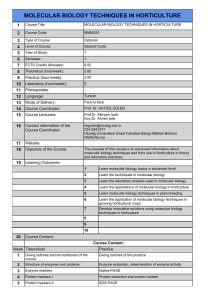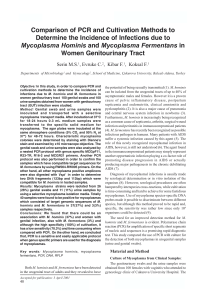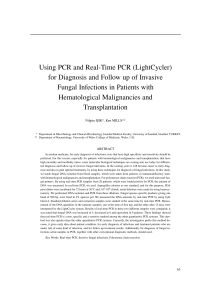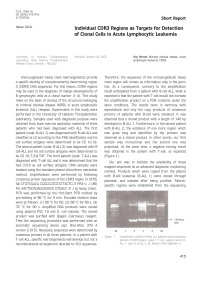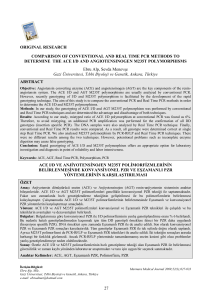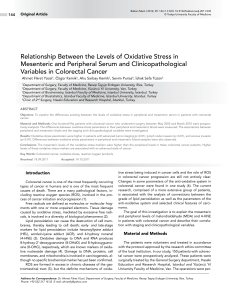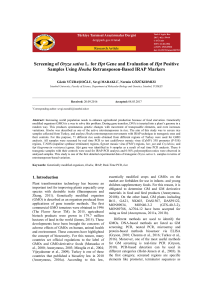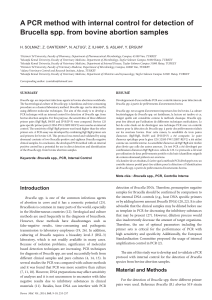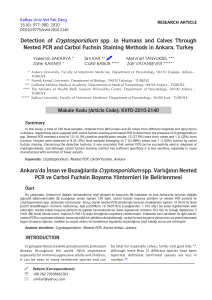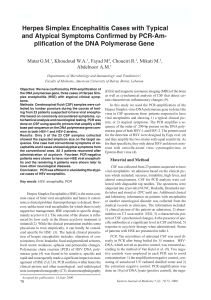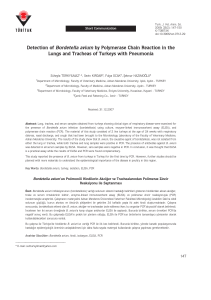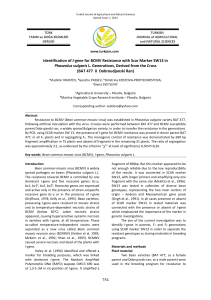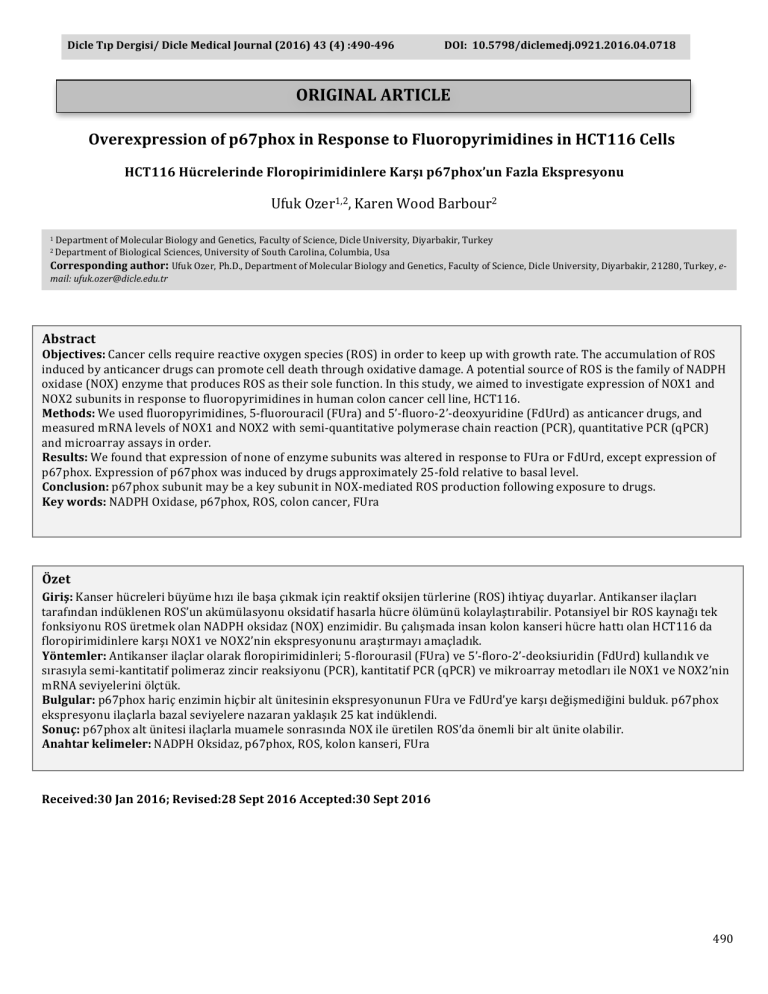
DicleTıpDergisi/DicleMedicalJournal(2016)43(4):490-496DOI:10.5798/diclemedj.0921.2016.04.0718
ORIGINALARTICLE
Overexpressionofp67phoxinResponsetoFluoropyrimidinesinHCT116Cells
HCT116HücrelerindeFloropirimidinlereKarşıp67phox’unFazlaEkspresyonu
2
UfukOzer1,2,KarenWoodBarbour
DepartmentofMolecularBiologyandGenetics,FacultyofScience,DicleUniversity,Diyarbakir,Turkey
2DepartmentofBiologicalSciences,UniversityofSouthCarolina,Columbia,Usa
Correspondingauthor:UfukOzer,Ph.D.,DepartmentofMolecularBiologyandGenetics,FacultyofScience,DicleUniversity,Diyarbakir,21280,Turkey,email:[email protected]
1
Abstract
Objectives:Cancercellsrequirereactiveoxygenspecies(ROS)inordertokeepupwithgrowthrate.TheaccumulationofROS
inducedbyanticancerdrugscanpromotecelldeaththroughoxidativedamage.ApotentialsourceofROSisthefamilyofNADPH
oxidase(NOX)enzymethatproducesROSastheirsolefunction.Inthisstudy,weaimedtoinvestigateexpressionofNOX1and
NOX2subunitsinresponsetofluoropyrimidinesinhumancoloncancercellline,HCT116.
Methods:Weusedfluoropyrimidines,5-fluorouracil(FUra)and5’-fluoro-2’-deoxyuridine(FdUrd)asanticancerdrugs,and
measuredmRNAlevelsofNOX1andNOX2withsemi-quantitativepolymerasechainreaction(PCR),quantitativePCR(qPCR)
andmicroarrayassaysinorder.
Results:WefoundthatexpressionofnoneofenzymesubunitswasalteredinresponsetoFUraorFdUrd,exceptexpressionof
p67phox.Expressionofp67phoxwasinducedbydrugsapproximately25-foldrelativetobasallevel.
Conclusion:p67phoxsubunitmaybeakeysubunitinNOX-mediatedROSproductionfollowingexposuretodrugs.
Keywords:NADPHOxidase,p67phox,ROS,coloncancer,FUra
Özet
Giriş:Kanserhücreleribüyümehızıilebaşaçıkmakiçinreaktifoksijentürlerine(ROS)ihtiyaçduyarlar.Antikanserilaçları
tarafındanindüklenenROS’unakümülasyonuoksidatifhasarlahücreölümünükolaylaştırabilir.PotansiyelbirROSkaynağıtek
fonksiyonuROSüretmekolanNADPHoksidaz(NOX)enzimidir.BuçalışmadainsankolonkanserihücrehattıolanHCT116da
floropirimidinlerekarşıNOX1veNOX2’ninekspresyonunuaraştırmayıamaçladık.
Yöntemler:Antikanserilaçlarolarakfloropirimidinleri;5-florourasil(FUra)ve5’-floro-2’-deoksiuridin(FdUrd)kullandıkve
sırasıylasemi-kantitatifpolimerazzincirreaksiyonu(PCR),kantitatifPCR(qPCR)vemikroarraymetodlarıileNOX1veNOX2’nin
mRNAseviyeleriniölçtük.
Bulgular:p67phoxhariçenziminhiçbiraltünitesininekspresyonununFUraveFdUrd’yekarşıdeğişmediğinibulduk.p67phox
ekspresyonuilaçlarlabazalseviyelerenazaranyaklaşık25katindüklendi.
Sonuç:p67phoxaltünitesiilaçlarlamuamelesonrasındaNOXileüretilenROS’daönemlibiraltüniteolabilir.
Anahtarkelimeler:NADPHOksidaz,p67phox,ROS,kolonkanseri,FUra
Received:30Jan2016;Revised:28Sept2016Accepted:30Sept2016
490
Özer and Barbour
INTRODUCTION
The generation and accumulation of reactive
oxygenspecies(ROS)canphysiologicallyoccur
as a by-product of functioning or damaged
mitochondria, by enzyme systems such as
peroxisomaloxidasesandlipoxygenases,andin
response to ROS-producing environmental
exposures or inflammatory conditions [1,2]. In
contrast, the family of NADPH oxidases (NOX)
produceROSastheirprimaryandsolefunction
[3,4]. This enzyme family occurs as multiprotein complexes consisting of a membranespanning catalytic NOX subunit and regulatory
subunits that are localized in the cytosol and
the membrane [3-5]. Among them, NOX1 and
NOX2 subunits are the best characterized.
Catalytic NOX1 and NOX2 subunits bind to a
common protein, p22phox in the membrane,
forming a membrane complex termed
flavocytochrome b558. The flavocytochrome
b558complexofNOX1bindstoNOXactivator1
(NOXA1) and NOX organizer 1 (NOXO1), while
the complex of NOX2 binds the respective
subunits p67phox and p47phox and p40phox.
Rac, a small GTPase, binds to NOXA1 and
p67phox upon activation of enzymes [5-7].
Assembly of all subunits brings about the
activation of NOX catalytic function, involving
the transportation of electrons from
cytoplasmic NADPH to FAD, first and second
heme groups, respectively and finally to
extracellularorphagosomaloxygentoproduce
superoxide(O2.-)[3,4,6].
Thefateofcancercellsisthusboundupbythe
levelofROSinducedbyanticancerdrugs[8].It
has been suggested that human tumor cells
generate their characteristically elevated ROS
levels by NOX, indicating the contribution of
thisenzymetocarcinogenesisforvarioustypes
ofcancer[4,9-13].Expressionandregulationof
NOX isoforms vary in tissues and are
differentially
localized
in
subcellular
compartments [5,14]. NOX1 and NOX2 are
potentially
important
targets
of
fluoropyrimidines,5-fluorouracil(FUra)andits
Original Article
nucleoside analog, 5’-fluoro-2’-deoxyuridine
(FdUrd),thatinduceROSformation,sincethey
are highly expressed in colon tissue [15,16].
For decades, fluoropyrimidines have been
widely used in chemotherapy of colorectal
cancer because of their strong cytotoxic
impacts. It is known that the activity of ROS
generating enzymes like NADPH oxidases is
increased to kill cancer cells [4,9]. Greater
efficacy in causing apoptotic programmed cell
death may be achieved by activating ROSproducingsystems.Therefore,theNOXenzyme
family by virtue of its ability to produce the
excessive ROS in colon cancer cells may be an
attractivetargetoffluoropyrimidines.
Here, in 3 different methods, we demonstrate
expression of NOX1 and NOX2 subunits in
human colon cancer cell, HCT116. Among all
NOX regulatory subunits, p67phox is the only
one whose expression is increased by drugs,
therebyindicatingthatitmaybeakeysubunit
inactivationofNOX2inHCT116cellsfollowing
exposuretodrugs.
METHODS
Cellculture
Human colon cancer cell line, HCT116 was
obtained from Dr. Michael G. Brattain. Cells
were grown in RPMI-1640 medium (Cellgro,
Corning, Manassas, VA, USA) supplemented
with 10% heat-activated fetal bovine serum
(FBS, Atlanta Biologicals) at 37 °C in a
humidified 5% CO2 atmosphere. Cells were
treated with fluoropyrimidines; FUra and
FdUrd (Sigma-Aldrich Co., St. Louis, MO, USA)
atconcentrationof10µMfor24hours.
Semi-quantitativePCR
In order to isolate total RNA, RNeasy Mini Kit
(Qiagen, Maryland, USA) was used and RNase
Free DNase Set (Qiagen, Hilden, Germany) as
applied to eliminate contaminating genomic
DNA.Eachsamples’RNAlevelsofsampleswere
spectrophotometrically measured at 260 and
280 nm absorbance (NanoDrop ND-1000
Spectrophotometer, Thermo Fisher Scientific,
43(4)2016www.diclemedj.org
491
Özer and Barbour
USA). According to manufacturer instructions,
1 µg RNA was reversely transcribed by iscript
cDNAsynthesiskit(Biorad,Hercules,CA,USA)
foreachreactioninaMycyclerThermalCycler
(Biorad, Hercules, CA). The samples were
incubated for 5 min in 25 °C, 30 min in 42 °C,
heated for 5 min in 85 °C and hold at 4 °C.
Indicated PCR cycles were used to determine
therelativeexpressionofeachgene.Inorderto
eliminate contamination, negative controls
includingnoreversetranscriptaseenzymeand
notemplateRNAwereusedforeachgene.The
differentPCRtubeswithineachserieswereset
up due to increasing numbers of amplification
cycles for each gene. Each reaction was run
with1μlofcDNAand250ngprimers(Table1,
IntegratedDNATechnologiesInc.,Coralville,IA,
USA) in a total volume of 25 μl, using GoTaq
HotStartGreenMasterMix(Promega,Madison,
WI,USA).
Table1:Primersusedforsemi-quantitativePCR
mRNA
p22
gp91
Primer(F:5’-3’,R:5’-3’)
F:ATGGAGCGCTGGGGACAGAAGTACATG
Product
Size(bp)
252
R:GATGGTGCCTCCGATCTGCGGCCG
F:TGGTACACACATCATCTCTTTGTG
558
R:AAAGGGCCCATCAAGCGCTATCTTAGGTAG
NOX1
F:TGAAGGACCTCTCCAGAATC
434
R:CAGGTGTGCAATGATGTG
p47phox
F:ACCCAGCCAGCACTATGTGT
767
R:AGTAGCCTGTGACGTCGTCT
p67phox
F:CGAGGGAACCAGCTGATAGA
747
R:CATGGGAACACTGAGCTTCA
NOXO1
F:GGCAGCCCTGGTGCAGATCAAGAGGC
281
R:CAGTCGCCAGCAGCCTCCGAGAATAGG
NOXA1
F:CCATCGACTACACGCAGCT
467
R:GTAGGCAGTCGACGTGCAGC
Rac1
F:GGTGAATCTGGGCTTATGGG
280
R:CTAGACCCTGCGGATAGGTG
GAPDH
F:ACCACCATGGAGAAGGCTGG
528
R:CTCAGTGTAGCCCAGGATGC
All PCR reactions consisted of an initial
denaturation step for 2 min at 95 °C and followed
bydenaturation(30sat95°C),annealingstep(30s
Original Article
at various temperature), extension (30 s at 72 °C)
andfinalextensionstep(5minat72°C).Annealing
step was 30 s at 50 °C for GAPDH, Rac1, NOXA1,
gp91andp67phox;at49.5°Cforp47phox;at60°C
for NOXO1 and at 52 °C for NOX1. Amplification
cyclesforGAPDHandRac1werefrom18to33and
32 to 44 for other genes. 1.5% (w/v) agarose gel
electrophoresis was used to resolve the amplified
cDNA products which were visualized by staining
with ethidium bromide (Sigma-Aldrich Co., St.
Louis,MO,USA).
QuantitativePCR
Power SYBR Green PCR Master Mix (Applied
Biosystems, Foster City, CA) was used for
amplifying cDNA (1 μl) according to the
manufacturer’sprocedures.PCRreactionswereset
upforonecycleat95°Cfor10min,and40cyclesof
95 °C for 15 s, 50 °C for 15 s and 72 °C for 40 s
utilizing an Applied Biosystems 7300 Real Time
PCRSystem.BydetectingSYBRgreenincorporation
during quantitative PCR (qPCR), all mRNA levels
were calculated relative to GAPDH as a reference
gene. Calculations and statistical analyses were
done as described in the manufacturer’s protocol.
Relativechangesineachgenelevelsbetweendrugtreated and control samples are expressed as fold
inductionrelativetothebasallevelofexpressionin
controlsamples.Table2showsprimers(Integrated
DNATechnologiesInc.,Coralville,IA,USA)usedfor
qPCR.
MicroarrayAnalysis
RNAwasisolatedfromHCT116cellstreatedin
quadruplicatewith10µMofFUrafor24hours.
RNeasy Mini Kit (Qiagen, Maryland, USA) was
used for the isolation from 6 x 106 cells and
RNase Free DNase Set (Qiagen, Hilden,
Germany) was performed to eliminate
contaminating genomic DNA according to the
recommendations of the manufacturer.
Utilizing the RNA 6000 Nano LabChip, 2100
Bioanalyzer(AgilentBiotechnologies)wasused
to measure the integrity and concentration of
the total RNA. The RNA integrity was checked
to make sure the quality of RNA and it ranged
from 9.8 to 10.0. RNA samples were amplified
and labeled using Agilent’s Low Input Quick
43(4)2016www.diclemedj.org
492
Özer and Barbour
Original Article
AmpLabelingKit(Cat.#5190-2306)according oflabeledcRNAsamplestoAgilentHumanGE4
tothemanufacturersuggestions.
x44Kv2Microarrays(Cat.#G4845A)at65°C
for 17 hours. We hybridized four control
Table2:PrimersusedforqPCR
sample replicates against four FUra treated
Product
mRNA
Primer(F:5’-3’,R:5’-3’)
Size(bp)
sample replicates in a dye swap design. After
F:ATGGAGCGCTGGGGACAGAAGTACATG
washes, Agilent DNA Microarray Scanner
p22
77
R:GATGGTGCCTCCGATCTGCGGCCG
System (Cat. # G2565CA) was utilized to scan
F:TGGTACACACATCATCTCTTTGTG
arrays.ImagesfromFeatureExtractorSoftware
gp91
94
R:AAAGGGCCCATCAAGCGCTATCTTAGGTAG
version 10.7.3.1 (Agilent) extracted data by
F:CTCCCTTGCCTCCATTCTC
correcting background utilizing additive and
NOX1
149
R:AGGCTATTGTCATGATCACTCC
multiplicative
detrending
algorithms.
F:AAAGTCAAGAGCGTGTCCC
Additionally,dyenormalizationwasperformed
p40phox
132
R:GAGGAAGATCACATCTCCAGC
bylinearandLOWESSmethods.Finaldatawas
F:ACACCTTCATCCGTCACATC
uploadedintoGeneSpringGXversion11.5.1for
p47phox
143
R:GAACTCGTAGATCTCGGTGAAG
analysis. This data was log2 transformed,
F:CGAGGGAACCAGCTGATAGA
quantilenormalizedandbaselinetransformed
p67phox
131
R:CATGGGAACACTGAGCTTCA
usingthemedianofallsamples.Then,datawas
F:AGATCAAGAGGCTCCAAACG
filtered by flags in a way that 100% of the
NOXO1
117
R:AGGTCTCCTTGAGGGTCTTC
samples in at least one of the two treatment
F:CAGGCTGTGGATCGTGG
groups have a “detected” flag. Analysis of the
NOXA1
150
R:CACGGCTTGGTCAAATGC
datawasdonewithanunpairedt-teststatistics
F:GGTGAATCTGGGCTTATGGG
todeterminedifferentiallyexpressedgenesand
Rac1
82
R:CTAGACCCTGCGGATAGGTG
thiswascorrectedformultipletestingusingthe
F:ACCACCATGGAGAAGGCTGG
Benjamini-Hochberg algorithm. A cutoff for pGAPDH
218
R:CTCAGTGTAGCCCAGGATGC
valuewas0.005.Tofilterdata,1.5wasusedas
afoldchangecutoffvalue.
Byusingapoly-dTprimerconsistingoftheT7 RNA polymerase promoter sequence, cDNA StatisticalAnalysis
was produced by mRNA from 200 ng of total All data were analyzed as the mean ± SEM.
RNA and. Then, cDNA samples were amplified Student’s t-test were performed to determine
by T7 RNA polymerase and were statistical significance of the mean for each
simultaneously incorporated by cyanine 3- or groups. Differences with P ≤ 0.05 were
cyanine 5-labeled CTP (cRNA). As an consideredstatisticallysignificant.
experimental quality control, Agilent RNA spike-in controls (Cat. # 5188-5279) were RESULTS
addedtosamplesbeforecDNAsynthesis.After Indication of drug-induced p67phox
amplificationandincorporationsteps,Qiagen’s expression by semi-quantitative PCR and
RNeasy Mini Kit (Cat. # 74104) was used for qPCR
purificationoflabeledRNAmolecules.Samples NOX isoforms are expressed in various tissues
werespectrophotometricallyassessedinterms and have different localizations in subcellular
of dye incorporation and cRNA yield and then compartments [5,14]. Previous studies had
stored at -80 °C until hybridization. According indicated that NOX enzyme contributes
to the manufacturer’s recommendations, elevation of ROS levels in various types of
Agilent’s Gene Expression Hybridization Kit cancer, implicating its strong cytotoxic effects
(Cat. # 5188-5242) was used for hybridization on cancer chemotherapy [4,9-13]. In order to
induceROS,fluoropyrimidinestargetNOX1and
43(4)2016www.diclemedj.org
493
Özer and Barbour
NOX2, which are highly expressed in colon
tissue[15,16].Assuch,thesedrugsmayinduce
expressionoftheirsubunits.
TotestwhethermRNAexpressionsofallNOX1
and NOX2 subunits―p22phox, NOX1, NOXA1,
NOXO1, NOX2, p67phox, p47phox, Rac, altered
by FdUrd in HCT116 cells, we utilized semiquantitative PCR method. mRNA levels were
detected semi-quantitatively in absence and
presence of FdUrd and GAPDH was used as an
experimental control. None of subunits, except
p67phox, were altered by FdUrd treatment
(Figure 1). HCT116 cells were treated with
FdUrdandqPCRwasdonetoverifyexpression
of p67phox mRNA levels induced by FdUrd. In
this assay, mRNA expression of another NOX2
regulatory subunit―p40phox was determined
aswell.Similarly,onlymRNAlevelsofp67phox
was induced by FdUrd about 28-fold (p<0.01)
amongallsubunits(Figure2).
Figure1.mRNAlevelsofNOX1andNOX2subunitsinresponse
toFdUrd.HCT116cellsweretreatedwith±10µMFdUrdfor24
h.Indicatedsubunitswereexaminedtoshowrelativelevelsof
mRNAsinuntreatedandFdUrdtreatedcellsbysemiquantitativePCR.GAPDHwastestedasaloadingcontrol.
IndicationofFUra-inducedp67phox
expressionbymicroarrayanalysis
In order to examine if mRNA expressions of
variousNOX1andNOX2subunitsischangedby
another fluoropyrimidine, FUra was used in
HCT116 cells. FUra treated to cells and
microarray analysis was done to measure
expression. Four sample replicates for both
controlandFUratreatmentwereaveragedand
represented by black color. Any sample below
average was indicated as green while sample
Original Article
overitwasshownasred.Withtheexceptionof
p67phox, expression of all NOX1 and NOX2
subunits were unchanged by FUra (Figure 3).
Thus, p67phox may be a key regulator of NOX
enzymeinresponsetoFdUrd.
DISCUSSION
Primary and sole function of NOX family is
producing O2.- by transporting electrons (e-)
across the membrane to reduce oxygen (O2)
[3,4]. They were expressed and localized in
subcellular compartments in diverse tissues
[5,14].IthasbeensuggestedthatNOXinduces
ROS levels in human tumor cells and
contributes to cytotoxicity [10-13] and ROS
generation in colorectal cancer is increased by
NOX1 and NOX2 enzymes [17,18]. Increase in
ROS can contribute to cell signaling and
proliferation, but the extent of ROS induction
altersthefateofcells.Theexcessiveamountof
ROS induced by NOX1 and NOX2 switches
scales of a balance between oxidative stress
anddefensecapabilityinfavorofthestress.
Fluoropyrimidines have been widely used in
chemotherapy of colorectal cancer for decades
due to their powerful cytotoxic impacts. NOX1
and NOX2 are potentially important targets of
these drugs that induce ROS formation, since
they are highly expressed in colon tissue
[15,16]. Activation of ROS-producing systems
may provide convenience to cancer cell death.
Thus, the NOX enzyme family may be a
considerable target of drugs as unique ROS
producers.
In this study, we examined gene expression of
NOX1 and NOX2 subunits in response to
fluoropyrimidines, FUra and FdUrd. We found
that except p67phox, expressions of all
subunits are not changed in treatment of
FdUrd. Induction in p67phox expression by
FdUrdwasconfirmedbysemi-quantitativePCR
and qPCR (Figure 1 and 2). Similarly, in
microarray assay, only p67phox expression
induced in treatment of FUra (Figure 3). This
showsthesedrugspotentiallyinduceNOX2via
p67phox, thereby indicating a possible target
43(4)2016www.diclemedj.org
494
Özer and Barbour
for fluoropyrimidine-directed therapy. Despite
requirement of future studies, NOX2 may be a
new target for chemotherapy in colorectal
cancer.
WeacknowledgeDr.FranklinG.Bergerfor
experimentalguidanceandthanktoDr.Diego
Altomareforhelpwithmicroarrays
experiment.
DeclarationofConflictingInterests:The
authorsdeclarethattheyhavenoconflictof
interest.
FinancialDisclosure:Thisworkwas
supportedbytheNationalCancerInstitute
[GrantCA44013]andtheNationalInstituteof
GeneralMedicalSciences[GrantGM103336].
REFERENCES
Figure2.Onlyp67phoxmRNAisinducedintreatmentof
FdUrd.HCT116cellsweretreatedwith±10µMFdUrdfor24h.
mRNAlevelsofNOX1andNOX2subunitswereassayedby
qPCRusingGAPDHasaloadingcontrol.Barsrepresentan
averageoffoldincrease±SEMfrom2separateexperiments
(*p<0.01).
Figure 3. Gene expression of NOX1 and NOX2 subunits in
response to FUra. HCT116 cells were treated in quadruplicate
with ± 10 µM FUra for 24 h. cDNAs are synthesized from
isolated mRNA samples. T7 RNA polymerase was added to
cDNA samples to amplify original mRNA molecules and was
added to cDNA samples and to simultaneously incorporate
cyanine 3- or cyanine 5-labeled CTP (cRNA) into the
amplification product. Labeled cRNA samples were hybridized
to Agilent Human GE 4 x 44K v2 Microarrays at 65 °C for 17
hours. Arrays were scanned using an Agilent DNA Microarray
ScannerSystem.
Original Article
1.BalabanRS,NemotoS,FinkelT.Mitochondria,oxidants,and
aging.Cell2005;120:483–95.
2.SchraderM,FahimiHD.Mammalianperoxisomesand
reactiveoxygenspecies.HistochemCellBiol.2004;122:383–93.
3.BedardK,KrauseKH.TheNOXfamilyofROS-generating
NADPHoxidases:physiologyandpathophysiology.PhysiolRev.
2007;87:245-313.
4.LambethJD.NOXenzymesandthebiologyofreactive
oxygen.NatRevImmunol.2004;4:181-9.
5.AltenhöferS,KleikersPW,RadermacherKA.TheNOX
toolbox:validatingtheroleofNADPHoxidasesinphysiology
anddisease.CellMolLifeSci.2012;69:2327-43.
6.HayesP,KnausUG.BalancingReactiveOxygenSpeciesinthe
Epigenome:NADPHOxidasesasTargetandPerpetrator.
AntioxidRedoxSignal.2013;18:1937-45.
7.WinglerK,HermansJJ,SchiffersP.NOX1,2,4,5:countingout
oxidativestress.BrJPharmacol.2011;164:866-83.
8.ZhouBB,ElledgeSJ.TheDNAdamageresponse:putting
checkpointsinperspective.Nature.2000;408:433-9.
9.KumarB,KoulS,KhandrikaL,etal.Oxidativestressis
inherentinprostatecancercellsandisrequiredforaggressive
phenotype.CancerRes.2008;68:1777–85.
10.KamataT.RolesofNox1andotherNoxisoformsincancer
development.CancerSci.2009;100:1382-8.
11.LaurentE,3rdMcCoyJW,MacinaRA,etal.Nox1isoverexpressedinhumancoloncancersandcorrelateswith
activatingmutationsinK-Ras.IntJCancer.2008;123:100-7.
12.LassègueB,GriendlingKK.NADPHoxidases:functionsand
pathologiesinthevasculature.ArteriosclerThrombVascBiol.
2010;30:653-61.
13.BánfiB,MaturanaA,JaconiS,etal.AmammalianH+
channelgeneratedthroughalternativesplicingoftheNADPH
oxidasehomologNOH-1.Science.2000;287:138-42.
14.BrownDI,GriendlingKK.Noxproteinsinsignal
transduction.FreeRadicBiolMed.2009;47:1239-53.
15.HwangPM,BunzF,YuJ,etal.Ferredoxinreductaseaffects
p53-dependent,5-fluorouracil–inducedapoptosisincolorectal
cancercells.NatMed.2001;7:1111-7.
16.JuhaszA,GeY,MarkelS,etal.ExpressionofNADPHoxidase
homologuesandaccessorygenesinhumancancercelllines,
tumoursandadjacentnormaltissues.FreeRadicRes.
2009;43:523-32.
Acknowledgements
43(4)2016www.diclemedj.org
495
Özer and Barbour
Original Article
17.KikuchiH,HikageM,MiyashitaH,etal.NADPHoxidase
subunit,gp91(phox)homologue,preferentiallyexpressedin
humancolonepithelialcells.Gene.2000;254:237-43.
18.PernerA,AndresenL,PedersenG,etal.Superoxide
productionandexpressionofNAD(P)Hoxidasesby
transformedandprimaryhumancolonicepithelialcells.Gut.
2003;52:231-6.
43(4)2016www.diclemedj.org
496

